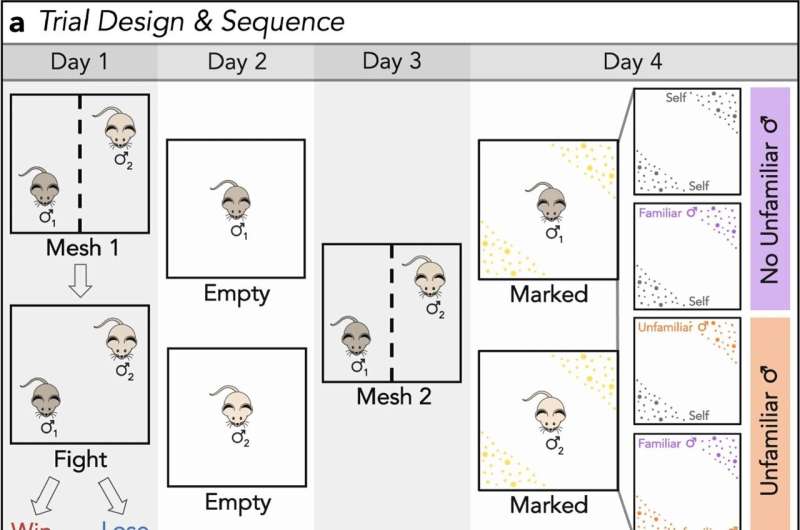This article has been reviewed according to Science X's editorial process and policies. Editors have highlighted the following attributes while ensuring the content's credibility:
fact-checked
peer-reviewed publication
trusted source
proofread
Research team captures social dynamics of 'pee-shy' mice

Urine scent marks are the original social media, allowing animals to advertise their location, status and identity. Now Cornell research is shining a new light—via thermal imaging of mice—on how this behavior changes depending on shifting social conditions.
The thermal recordings show that mice that recently lost a fight become "pee shy," while the victors increase their frequency of marking. The speed and tempo of urination change, too, with males quicker to scent mark after fighting.
Because mice have a limited amount of urine on reserve, understanding how they decide to release it—or hold it in—gives scientists insight into the ways that animals manage their social signaling.
The group's paper, "Dynamic Changes to Signal Allocation Rules in Response to Variable Social Environments in House Mice," published March 21 in Communications Biology. The lead author is Caitlin Miller, Ph.D. '22, a postdoctoral researcher at Scripps Research Institute. The team was led by senior author Michael Sheehan, an associate professor in the Department of Neurobiology and Behavior, which is shared between the College of Arts and Sciences and the College of Agriculture and Life Sciences.
Sheehan and Miller were particularly interested in seeing if and how mice vary the way they communicate as their social environment changes.
That form of communication just happens to be a little messier than ours.
"Mice are peeing constantly. And their world is very scent oriented, in a really extreme way," Sheehan said. "By deciding when and where to urine mark, mice are managing their social profiles that other mice pay attention to."
However, because mice piddle in such incredibly small amounts, and prefer to do their business in the dark, the activity has been difficult to document. Sheehan discovered an alternate method for studying animal urination—by stepping in it.
"Our former dog was getting old and incontinent and she was starting to pee in the house. I woke up one morning, walked downstairs and stepped in a puddle of cold pee. It made me realize, 'Oh, right, thermal signature,'" Sheehan said. "Urine leaves the body warm and then cools, providing a distinctive thermal trace, so we can measure marking behavior with a lot of spatial and temporal detail."
The thermal-imaging cameras captured a variety of interactions that revealed male mice to be more nuanced and flexible in their responses and decision-making than previously reported.
"The thing that's really dramatic is when they won and they smell a novel mouse's pee, they're rapidly dribbling pee all over the place," Sheehan said. "And when they've lost, they go silent. They're not peeing anymore. So even though they never met this new male, the fact that they lost a couple days earlier changes their strategy. They're like, 'Oh, nope, hold it in.'"
But withholding urine too often has a downside. In another paper, published Feb. 15 in Proceedings of the Royal Society B, the group found that males face social costs if they underinvest in marking. Low-peeing males that won their fights had a more difficult time winning, with more intensive combat that lasted longer. The mice that fought them were apparently less willing to surrender to weak-signalers.
Taken together, the papers illuminate the pros and cons of how animals budget crucial resources to manage their social signaling.
"Pee is metabolically costly for mice to make because they use it to deposit pheromone proteins around their environment," Miller said. "Think of body builders; can you imagine if none of the protein they're consuming is going to their body, it's just going out into the world? And that's a thing that male mice have to encounter in terms of tradeoff. Does this protein go to me? Or does this protein go into the world so that I can communicate with others?"
"Mice are under strong selection to get the balance of costs and benefits of urine-marking right," Sheehan said. "If we can understand those decision rules, we can better understand how evolution optimizes efforts to produce and broadcast social information."
More information: Caitlin H. Miller et al, Dynamic changes to signal allocation rules in response to variable social environments in house mice, Communications Biology (2023). DOI: 10.1038/s42003-023-04672-x
Journal information: Proceedings of the Royal Society B , Communications Biology
Provided by Cornell University

















